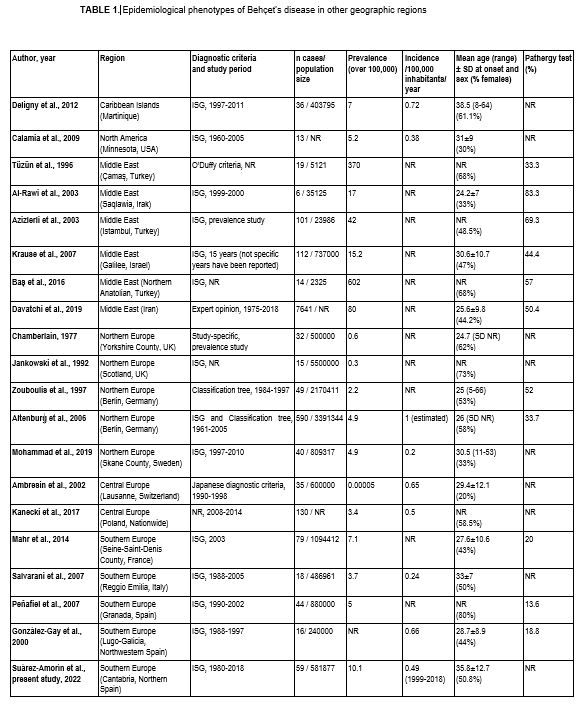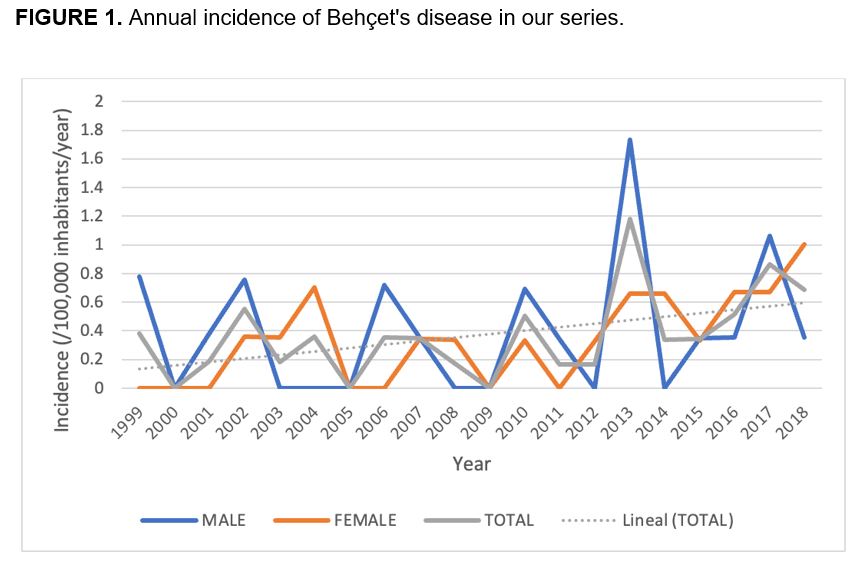Back
Poster Session B
Epidemiology, health policy and outcomes
Session: (0695–0723) Epidemiology and Public Health Poster I
0695: Epidemiology of Behçet’s Disease in Northern Spain
Sunday, November 13, 2022
9:00 AM – 10:30 AM Eastern Time
Location: Virtual Poster Hall
- CA
Carmen Alvarez Reguera, MD
Hospital Universitario Marqués de Valdecilla
Santander, Spain
Abstract Poster Presenter(s)
Carmen Alvarez Reguera1, guillermo Suárez-Amorin1, Rosalía Demetrio-Pablo1, Raúl fernández-ramón1, Alba Herrero-Morant2, Lara Sánchez-Bilbao1, David Martínez-López1, José Luis Martín-Varillas3, Santos Castañeda4, Miguel Ángel González-Gay5 and Ricardo Blanco6, 1Hospital Universitario Marqués de Valdecilla, Santander, Spain, 2Hospital Universitario Marqués de Valdecilla, Ontinyent, Spain, 3Hospital de Laredo, Laredo, Cantabria, Spain, 4Division of Rheumatology, Hospital Universitario de La Princesa, IIS-Princesa, Madrid, Spain, 5Department of Medicine and Psychiatry, Universidad de Cantabria; Rheumatology Division, Hospital Universitario Marqués de Valdecilla; Research group on genetic epidemiology and atherosclerosis in systemic diseases and in metabolic diseases of the musculoskeletal system, IDIVAL, Santander, Spain. Cardiovascular Pathophysiology and Genomics Research Unit, School of Physiology, Faculty of Health Sciences, University of the Witwatersrand, Johannesburg, South Africa, 6Hospital Universitario Marqués de Valdecilla, IDIVAL, Santander, Spain
Background/Purpose: The prevalence of Behçet’s disease (BD) has a considerable geographical and temporal variability. Data regarding epidemiology in Spain are limited. Our study aimed to assess the epidemiology and clinical domains of BD in a population-based cohort from northern Spain and to compare the results with other geographical areas.
Methods: We conducted a cross-sectional study of a well-defined population in Northern Spain. Cases of suspected BD between January 1980 and December 2018 were identified. The diagnosis of BD was established according to the International Study Group (ISG) for Behçet’s Disease. The incidence of BD between 1999 and 2018 was estimated by sex, age, and year of diagnosis.
Results: Of 120 patients with probable BD, 59 patients met ISG criteria and were finally included in the study, with a male/female ratio of 0.97; mean age 49.7±14.7 years. Incidence during the period of study was 0.492 per 100,000 people, observing an increase from January 1999 to December 2018. Prevalence was 10.14 per 100,000 in 2018. Clinical manifestations were relapsing aphthous stomatitis (100%), genital ulcers (78%), skin involvement (84.7%), joint involvement (64.4%), uveitis (55.9%), central nervous system (16.9%), vascular (10.2%), and gastrointestinal manifestations (6.8%).
Conclusion: The prevalence of BD in Cantabria is higher than in other Southern-European countries. This difference may reflect a combination of geographic, genetic, or methodological variations, as well as the free accessibility to the Spanish Public Health System. Clinical phenotypes observed are similar to those described in other world regions.
 Abbreviations: ISG: International Study Group; ICBD: International Criteria for Behçet’s Disease; NR: Not Reported; SD: Standard Deviation.
Abbreviations: ISG: International Study Group; ICBD: International Criteria for Behçet’s Disease; NR: Not Reported; SD: Standard Deviation.

Disclosures: C. Alvarez Reguera, None; g. Suárez-Amorin, None; R. Demetrio-Pablo, None; R. fernández-ramón, None; A. Herrero-Morant, None; L. Sánchez-Bilbao, Eli Lilly; D. Martínez-López, None; J. Martín-Varillas, AbbVie/Abbott, Pfizer, Janssen, UCB, Celgene; S. Castañeda, Roche; M. González-Gay, AbbVie/Abbott, Merck/MSD, Janssen, Roche, AbbVie/Abbott, Roche, Sanofi, Eli Lilly, Celgene, Sobi, Merck/MSD; R. Blanco, Eli Lilly, Pfizer, Roche, Janssen, MSD, AbbVie, Amgen, AstraZeneca, Bristol Myers Squibb, Galapagos, Novartis, Sanofi.
Background/Purpose: The prevalence of Behçet’s disease (BD) has a considerable geographical and temporal variability. Data regarding epidemiology in Spain are limited. Our study aimed to assess the epidemiology and clinical domains of BD in a population-based cohort from northern Spain and to compare the results with other geographical areas.
Methods: We conducted a cross-sectional study of a well-defined population in Northern Spain. Cases of suspected BD between January 1980 and December 2018 were identified. The diagnosis of BD was established according to the International Study Group (ISG) for Behçet’s Disease. The incidence of BD between 1999 and 2018 was estimated by sex, age, and year of diagnosis.
Results: Of 120 patients with probable BD, 59 patients met ISG criteria and were finally included in the study, with a male/female ratio of 0.97; mean age 49.7±14.7 years. Incidence during the period of study was 0.492 per 100,000 people, observing an increase from January 1999 to December 2018. Prevalence was 10.14 per 100,000 in 2018. Clinical manifestations were relapsing aphthous stomatitis (100%), genital ulcers (78%), skin involvement (84.7%), joint involvement (64.4%), uveitis (55.9%), central nervous system (16.9%), vascular (10.2%), and gastrointestinal manifestations (6.8%).
Conclusion: The prevalence of BD in Cantabria is higher than in other Southern-European countries. This difference may reflect a combination of geographic, genetic, or methodological variations, as well as the free accessibility to the Spanish Public Health System. Clinical phenotypes observed are similar to those described in other world regions.
 Abbreviations: ISG: International Study Group; ICBD: International Criteria for Behçet’s Disease; NR: Not Reported; SD: Standard Deviation.
Abbreviations: ISG: International Study Group; ICBD: International Criteria for Behçet’s Disease; NR: Not Reported; SD: Standard Deviation.
Disclosures: C. Alvarez Reguera, None; g. Suárez-Amorin, None; R. Demetrio-Pablo, None; R. fernández-ramón, None; A. Herrero-Morant, None; L. Sánchez-Bilbao, Eli Lilly; D. Martínez-López, None; J. Martín-Varillas, AbbVie/Abbott, Pfizer, Janssen, UCB, Celgene; S. Castañeda, Roche; M. González-Gay, AbbVie/Abbott, Merck/MSD, Janssen, Roche, AbbVie/Abbott, Roche, Sanofi, Eli Lilly, Celgene, Sobi, Merck/MSD; R. Blanco, Eli Lilly, Pfizer, Roche, Janssen, MSD, AbbVie, Amgen, AstraZeneca, Bristol Myers Squibb, Galapagos, Novartis, Sanofi.

